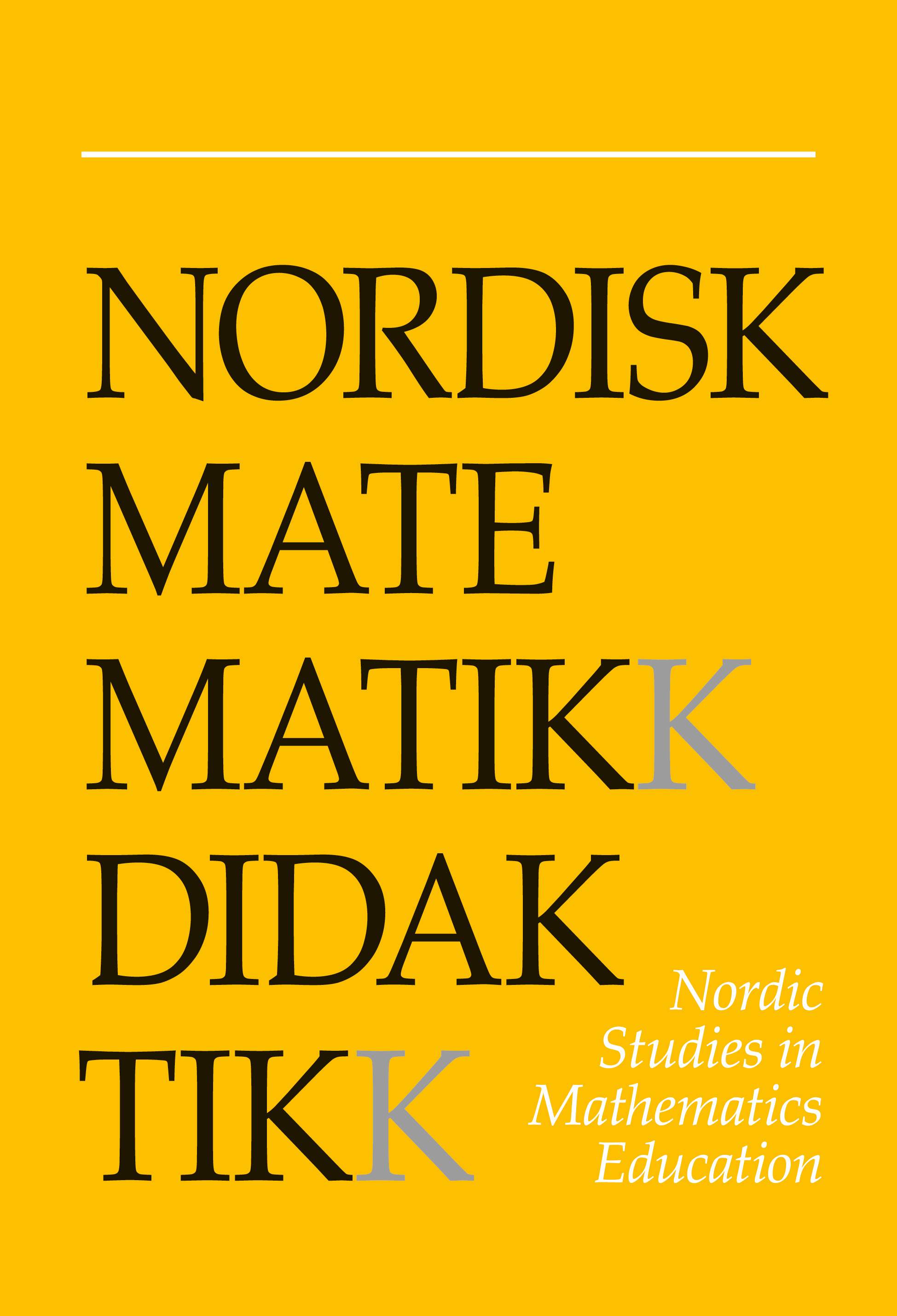Learning linear relationships through independent use of the mathematics textbook
DOI:
https://doi.org/10.7146/nomad.v21i2.148722Abstract
This paper discusses the participation of one Grade 8 student in a typical Swedish mathematics class as she tried to learn independently about linear relationships, mainly through the mathematics textbook. Since this set-up has the possibility for every student to progress at different rates, only one student, through data from ten consecutive lessons, was considered. Results from an analysis of this student’s use of the textbook showed that the textbook is used independently more as an instrument for learning mathematics rather than an object of learning mathematics. However, further studies are required to determine the extent of learning and the development of mathematical skills.
References
Brändström, A. (2005) Differentiated tasks in mathematics textbooks. An analysis of the levels of difficulty (Licentiate thesis). Luleå University of Technology.
Carlsson, S., Hake, K. B. & Öberg, B. (2002). Matte direkt år 8. Stockholm: Bonnier Utbildning AB.
Carlsson, S., Hake, K. B. & Öberg, B. (2010). Matte direkt 8 (revised version). Stockholm: Bonnier Utbildning AB.
Clarke, D. (2006). The LPS research design. In D. J. Clarke, C. Keitel & Y. Shimizu (Eds.), Mathematics classrooms in twelve countries. The insider's perspective (LPS Book series, vol. 1, pp. 15-36). Rotterdam: Sense Publishers. https://doi.org/10.1163/9789087901622_003
Cobb, P., Stephan, M., McClain, K. & Gravemeijer, K. (2001). Participating in mathematical classroom practices. The Journal of the Learning of Science, 10 (1 & 2), 113-163. https://doi.org/10.1207/S15327809JLS10-1-2_6
Emanuelsson, J. & Sahlström, F. (2008). The price of participation - how interaction constrains and affords classroom learning of mathematics. Scandinavian Journal of Educational Research, 52 (2), 205-223. https://doi.org/10.1080/00313830801915853
Engeström, Y. (2000). Activity theory as a framework for analyzing and redesigning work. Ergonomics, 43 (7), 960-974. https://doi.org/10.1080/001401300409143
Fujita, T. & Jones, K. (2003) Critical review of geometry in current textbooks in lower secondary schools in Japan and in the UK. In N. Pateman, B. Dougherty & J. Zilliox (Eds.), Proceedings of the 27th conference of the International Group of the Psychology of Mathematics Education (vol. 1, p. 220). Hawaii: PME.
Gallos Cronberg, F. & Emanuelsson, J. (2013). Martina's voice. In B. Kaur, G. Anthony, M. Ohtani & D. Clarke (Eds.), Student voice in mathematics classrooms around the world (pp. 89-114). Rotterdam: Sense Publishers. https://doi.org/10.1007/978-94-6209-350-8_6
Grevholm, B. (2011). Network for research on mathematics textbooks in the Nordic countries. Nordic Studies in Mathematics Education, 16 (4), 91-102.
Hansson, Å. (2010). Instructional responsibility in mathematics education: modelling classroom teaching using Swedish data. Educational Studies in Mathematics, 75, 171-189. https://doi.org/10.1007/s10649-010-9249-2
Jamieson-Proctor, R. & Byrne, C. (2008). Primary teachers' beliefs about the use of mathematics textbooks. In M. Goos, R. Brown & K. Makar (Eds.), Navigating currents and charting directions. Proceedings of the 31st annual conference of the Mathematics Education Research Group of Australasia (pp. 295-302). Brisbane: MERGA.
Johansson, M. (2003). Textbooks in mathematics education. A study of textbooks as the potentially implemented curriculum (Licentiate thesis). Luleå University of Technology.
Johansson, M. (2006). Teaching mathematics with textbooks. A classroom and curricular perspectives (PhD thesis). Luleå University of Technology.
Maykut, P. & Morehouse, R. (1994). Beginning qualitative research. A philosophical and practical guide. London: The Falmer Press.
Mullis, I. V. S., Martin, M. O. & Foy, P. (2008). TIMSS 2007 international mathematics report: findings from IEA's trends in international mathematics and science study at the fourth and eighth grades. Chestnut Hill: TIMSS & PIRLS International Study Center, Boston College.
Pepin, B. (2009). Mathematical tasks and the learner dispositions: a comparative perspective. In V. Durand-Guerrier, S. Soury-Lavergne & F. Arzarello (Eds.), Proceedings of CERME 6 (pp. 2504-2512). Lyon: ERME.
Rezat, S. (2006). A model of textbook use. In J. Novotna et al. (Eds.), Proceedings of the 30th conference of the international Group for the Psychology of Mathematics Education (vol. 4, pp. 409-416). Prague: PME.
Rezat, S. (2009). The utilization of mathematics textbooks as instruments for learning. In V. Durand-Guerrier, S. Soury-Lavergne & F. Arzarello (Eds.), Proceedings of CERME 6 (pp. 1260-1269). Lyon: ERME.
Skolverket. (2008). TIMSS 2007. Swedish pupils' mathematical knowledge. Stockholm: Author.
Skolverket. (2011). Curriculum for the compulsory school, preschool class and the leisure-time centre 2011 [English version]. Stockholm: Author.
Skolverket. (2012). TIMSS 2011. Svenska grundskoleelevers kunskaper i matematik och naturvetenskap i ett internationellt perspektiv. Stockholm: Author.
Valverde, G., Bianchi, L., Wolfe, R., Schmidt, W. & Houang, R. (2002). According to the book: using TIMSS to investigate the translation of policy through the world of textbooks. London: Kluwer Academic Publisher. https://doi.org/10.1007/978-94-007-0844-0
Vygotsky, L. (1978). Mind in society: The development of higher psychological processes. Cambridge: Harvard University Press.
Downloads
Published
How to Cite
Issue
Section
License

This work is licensed under a Creative Commons Attribution-NonCommercial-ShareAlike 4.0 International License.



